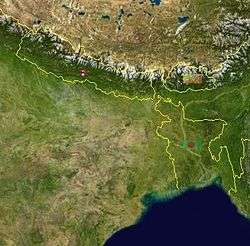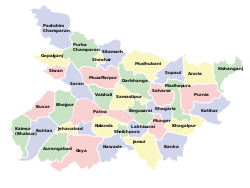Geography of Bihar
Bihar is located in the eastern region[3] of India between latitude 24°-20'-10" N ~ 27°-31'-15" N and longitude 83°-19'-50" E ~ 88°-17'-40" E. It is an entirely land–locked state, in a subtropical region of the temperate zone. Bihar lies between the humid West Bengal in the east and the sub humid Uttar Pradesh in the west, which provides it with a transitional position in respect of climate, economy and culture. It is bounded by Nepal in the north and by Jharkhand in the south. Bihar plain is divided into two unequal halves (North Bihar and South Bihar) by the river Ganges[4] which flows through the middle from west to east. Bihar's land has average elevation above sea level of 173 feet.
| Geography of Bihar | |
|---|---|
 | |
| Country | |
| Region | Indo-Gangetic plain, East India |
| Coordinates | 24°-20'-10" N ~ 27°-31'-15" N (latitude) and 83°-19'-50" E ~ 88°-17'-40" E longitude[1] |
| Area | Ranked 13 94,163 km2 (36,357 sq mi) |
| Borders | North Side – Nepal South-East Side – West Bengal West Side – Uttar Pradesh South Side – Jharkhand |
| Mountains | Rajgir hills, Brahmayoni Hill, Pretshila Hill, Ramshila Hill |
| Rivers | Ganges, Phalgu, Ghaghra, Gandak, Budhi Gandak, Bagmati, Kamla, Bhutahi Balan, Kosi,Mohana, Mahananda, Son, Punpun Kanchan river in purushottam pur village buxar[2] |
| Longest river | Ganges |
| Waterfalls | Kakolat, Manjhar Kund, Dhua Kund, North Tank |
| Natural resources | Steatite, Pyrites, Quartzite, Crude Mica, Limestone |
| Natural hazards | Floods |
Political geography
The state is divided into 9 divisions and 38 districts, for administrative purposes. which are listed below.

Geology
Bihar is in Indo-Gangetic plain so naturally fertile soil is one asset of the state. Thus Indo-Gangetic plain's soil is the backbone of agricultural and industrial development. The Indo-Gangetic plain in Bihar consists of a thick alluvial mantle of drift origin overlying in most part, the siwalik and older tertiary rocks. The soil is mainly little young loam rejuvenated every year by constant deposition of silt, clay and sand brought by streams but mainly by floods in Bihar[5]
This soil is deficient in phosphoric acid, nitrogen and humus, but potash and lime are usually present in sufficient quantity. The most common soil in Bihar is Gangetic alluvium of Indo-Gangetic plain region, Piedmont Swamp Soil which is found in northwestern part of West Champaran district and Terai Soil which is found in eastern part of Bihar along the border of Nepal.[6] clay soil, sand soil and loamy soil are common in Bihar.[7]
Natural resources
Bihar is mainly a vast stretch of very fertile flat land. It is drained by the Ganges River, including northern tributaries of other river. The Bihar plain is divided into two unequal halves by the river Ganges which flows through the middle from west to east. Other Ganges tributaries are the Son, Budhi Gandak, Chandan, Orhani and Phalgu. The Himalayas begin at foothills a short distance inside Nepal but influence Bihar's landforms, climate, hydrology and culture. Central parts of Bihar have some small hills, for example the Rajgir hills. The Himalayan Mountains are to the north of Bihar, in Nepal. To the south is the Chota Nagpur plateau, which was part of Bihar until 2000 but now is part of a separate state called Jharkhand.
1.Forest
Bihar has notified forest area of 6,764.14 km², which is 7.1 per cent of its geographical area.[8] The sub Himalayan foothill of Someshwar and Dun ranges in Champaran district another belt of moist deciduous forests. These also consists of shrub, grass and reeds. Here the rainfall is above 1,600 mm and thus promotes luxuriant Sal forests in the favoured areas. The hot and dry summer gives the deciduous forests. The most important trees are Shorea Robusta (Sal), Shisham, Cedrela Toona, Khair, and Semal. This type of forests also occurs in Saharsa district and Purnia district.[9]
2.Minerals
Bihar is a producer of Steatite (945 tonnes), Pyrites (9,539 tonnes/year), Quartzite (14,865 tonnes/year), Crude Mica (53 tonnes/year), Limestone (4,78,000 tonnes/year). Bihar has also some good resource of Bauxite in Jamui district, Cement Mortar in Bhabhua, dolomite in Bhabhua, Glass sand in Bhabhua, Mica in Muzaffarpur, Nawada, Jamui, Gaya and salt in Gaya and Jamui, Uranium and Beryllium are found in Gaya District,Coal in Rajmahal Coalfield, Gold In Jamui, [10]
Water bodies
|
|
|

Hills
- Rajgir hills
- Barabar hills
- Bateshwar hills
- Kaimur Range
- Brahmayoni hills
- Pretshila hills
- Ramshila hills
Natural hazards
Flood
Total human deaths is 5874 and animal deaths is 19044 in Bihar due to floods between 1979–2006[11][12]
Bihar is India's most flood-prone State, with 76% of the population in the north Bihar living under the recurring threat of flood devastation.[13] According to some historical data, 16.5% of the total flood affected area in India is located in Bihar while 22.1% of the flood affected population in India lives in Bihar.[14] About 68,800 square kilometres (26,600 sq mi) out of total geographical area of 94,160 square kilometres (36,360 sq mi) comprising 73.06% is flood affected. Floods in Bihar are a recurring disaster which on an annual basis destroys thousands of human lives apart from livestock and assets worth millions.[13]
Drought & Famine
Climate
Bihar is cold in the winter, the lowest temperatures being around 0–10 degrees Celsius (32 to 50 degrees Fahrenheit). Winter months are December and January. It is hot in the summer with average highs around 35–45 Celsius ( 95–105 Fahrenheit). April to mid June are the hot months. The monsoon months of June, July, August, and September see good rainfall. October & November and February & March have cool, pleasant climate.
See also
- 1934 Nepal–Bihar earthquake
- Climate of Bihar
- Floods in Bihar
References and footnotes
- "Archived copy". Archived from the original on 2009-04-09. Retrieved 2008-11-27.CS1 maint: archived copy as title (link)
- "Archived copy". Archived from the original on 2008-12-18. Retrieved 2008-11-19.CS1 maint: archived copy as title (link)
- "GSI – Eastern Region". Geographical Survey of India, Government of India. Archived from the original on 24 September 2015. Retrieved 11 June 2014.
- "Bihar Area". mapsofindia.com. Archived from the original on 24 June 2014. Retrieved 11 June 2014.
- Das, K.K.L.; Das, K.N. (1981), "Alluvial Morphology of the North Bihar Plain – A study in applied geomorphology", in Sharma, Hari Shanker (ed.), Perspectives in geomorphology, 4, New Delhi: Naurung Rai Concept Publishing Company, pp. 85 ff., retrieved April 9, 2011
- Soil of Bihar Archived 2011-09-28 at the Wayback Machine
- other common soil in Bihar Archived 2008-07-06 at the Wayback Machine
- "State Profile". Gov. of India. Archived from the original on 2008-12-18.
- "Forest in Bihar". Forest Ministry of Bihar. Archived from the original on 2009-04-10.
- "Archived copy". Archived from the original on 2008-12-26. Retrieved 2008-11-27.CS1 maint: archived copy as title (link)
- Disaster Management in Bihar Archived 2008-10-23 at the Wayback Machine
- Disaster Management in Bihar – Statistics Archived 2008-10-19 at the Wayback Machine
- Flood Management Information System – History of Flood in Bihar Archived 2010-04-19 at the Wayback Machine
- India Water Portal – Bihar Floods 2008 Archived 2009-02-01 at the Wayback Machine